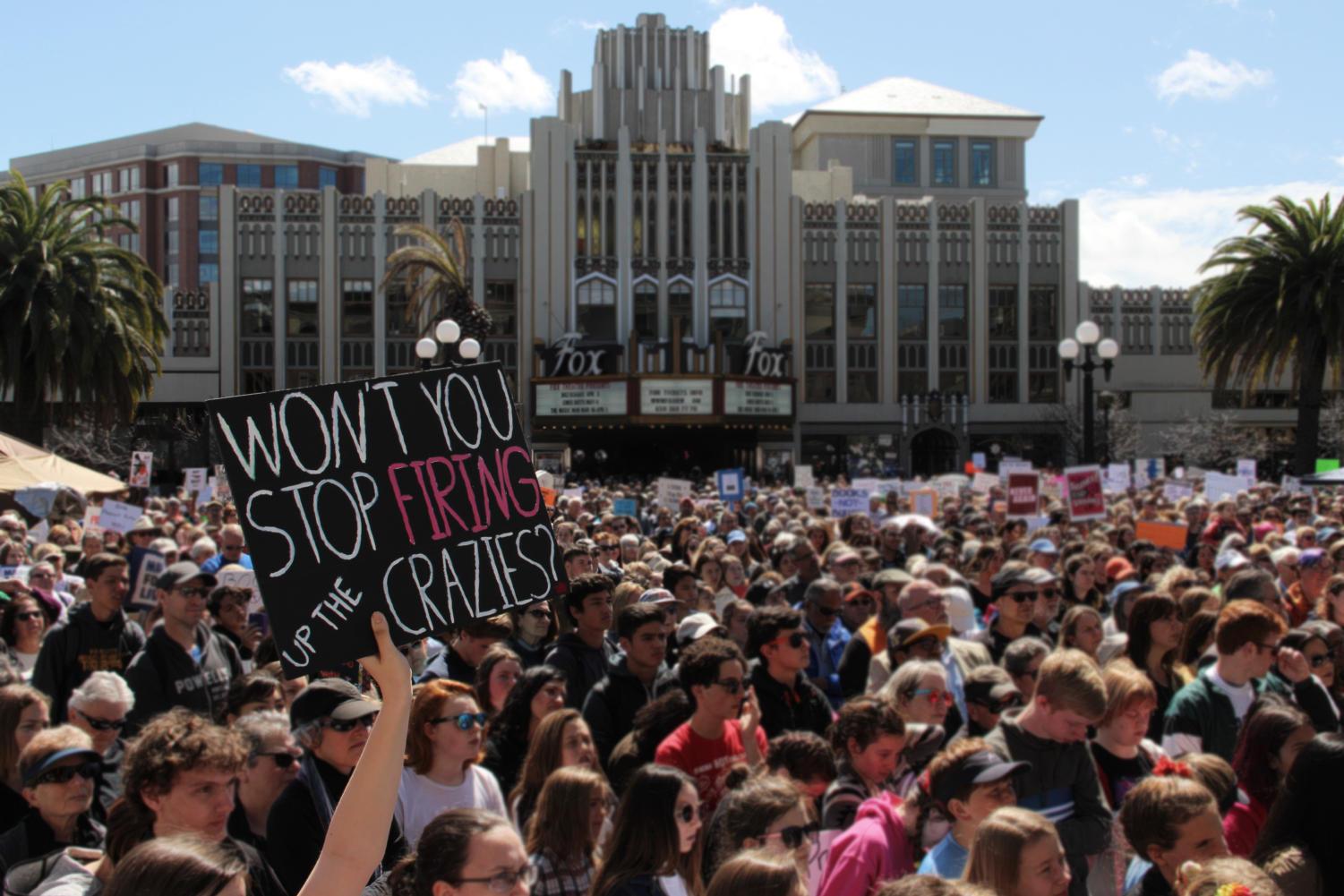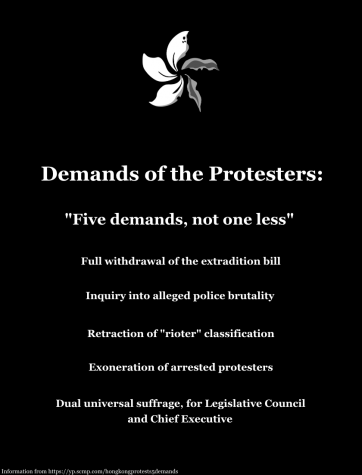
Twitter: @jackhansen108


February 18, 2020
One million, two hundred thousand.
That’s how many people protested in the 2018 March for Our Lives.
Two million.
This is the number of people protesting in Hong Kong on June 16, 2019, according to the Civil Human Rights Front.
These two events are some of the many demonstrations taking place around the world, with hundreds of more past protests. Every protest has different causes, different goals, and different supporters, but each has one uniting factor: the desire for change.

Martin Luther King Jr. addresses his followers during the March on Washington, which was a turning point for the civil rights movement.
On Aug. 28, 1963, Martin Luther King Jr. gave his famous “I Have a Dream” speech to an audience of over 250,000 people, according to Britannica. The March on Washington was one of the culminations of King’s struggle for civil rights for all races in America. It also became one of the most significant historical moments in a protest.
Throughout human history, especially in the 20th and 21st centuries, protests have been one of the driving forces for change. King paraphrased Theodore Parker’s quotation about humanity’s morals when he said, “The arc of the moral universe is long, but it bends toward justice.”
Looking back 100 years, one can see the progress made in the last century.
The women’s rights, civil rights, and LGBTQ+ movement as well as the fall of the Berlin Wall, Gandhi’s Salt March, and protests against the Vietnam War serve as prevalent proof of the power of protests, which largely dictated the outcomes of many of these movements. Ultimately, people fighting for what they believe has progressed society throughout time.
“It is a problem of institutions. Bureaucracies inevitably start favoring themselves over their missions. In theocracies and dictatorships of all kinds, change only comes through revolution. Even in democracies, fundamental change needs a revolution,” said Chris Hables Gray, a lecturer at the University of California at Santa Cruz.
Gray has taught since the 1970s, mainly in cultural studies of science and technology, as well as ethics and the history of social movements. He has also protested for much of his life and has been arrested more than 10 times while demonstrating.
While no movement is guaranteed to fail or succeed, certain aspects help the likelihood that a movement will prove to be worthwhile.
“A single protest can succeed if the aims are focused and limited and the target is open to the kind of pressure supplied. Such focused protests work often. A movement can succeed if it has deep organizing, mass support, and realistic goals,” Gray said.
Gandhi’s Salt March was one of the protests that worked when given a specific goal. The Salt March aimed to protest the British monopoly and tax on salt in India and, as a result, the British repealed the law. This peaceful demonstration was evidently more effective than trying to fight British rule all at once.
While many tactics have stayed the same over time, social media has changed the way the majority of protests are organized and run. Social media is a new way to spread information, similar to the printing press’ impact on Europe in the Renaissance.
The ability to spread information more effectively, however, is a double-edged sword. Where one movement can spread its goal, opposition to the movements have the same power.

People of all ages, ethnicities, and political ideologies gathered together in front of Redwood City Courthouse to demand greater gun control legislation.
One such movement that uses social media to its advantage is the youth-led March for Our Lives, which aims to reduce and eventually eliminate gun violence across the United States. The organization intends to implement its C.H.A.N.G.E. peace plan. Parts of the plan include halving the number of gun deaths in 10 years and changing the requirements for owning guns.
“I think being able to utilize social media has been a blessing,” said Jessica Riestra, one of the co-directors in March for Our Lives California. “[Social media] also has repercussions when it comes to the activism world, but for the most part, we’ve been able to reach out to more people.”
I truly believe young people are the change-makers of this generation.
— Jessica Riestra
March for Our Lives uses social media to help their cause and to connect as many people as possible. Riestra cites social media as a way to spread financial help, such as through the GoFundMe page for Saugus High School in the wake of the Santa Clarita shooting. The use of social media in the movement has also allowed March for Our Lives to connect people who want to take part in the movement.
Although March for Our Lives still has a long way to go, Riestra believes that as more youth reach voting age, more progress will be made.
“I truly believe young people are the change-makers of this generation,” Riestra said. “With everything that is happening, we don’t necessarily know where we’re going, but it’s just based on the decisions that we’re making, and we’re changing that.”
While March for Our Lives has the potential to succeed in part because of its support among the youth, it also has the focused goals that Gray said can help a movement succeed. Within its C.H.A.N.G.E. plan, it has specific aims that the movement can accomplish individually. Some of them involve talking to politicians to create new laws, while other goals incoorporate spreading the message to the youth.
Even when fighting against gun violence, the members of March for Our Lives support one another through the challenges.
“We have a humanistic approach that we all empathize, and we’re all here for one another in these times of need,” Riestra said. “At the same time, it also brings up the activism approach. Even though [the Santa Clarita shooting] was a horrifying event, it’s not going to stop people from being able to take action.”

Reporters and protesters in Hong Kong protect themselves from tear gas with umbrellas and masks. Protesters use umbrellas in a variety of ways in their ongoing protests.
While members of the youth are fighting to reduce gun violence in the United States, people of all ages and backgrounds are fighting for their freedom in Hong Kong.
Citizens in Hong Kong have been protesting against China since March 2019. The movement started partly because of the extradition bill, which many people feared would give China too much power over Hong Kong. As of Oct. 23, 2019, the bill was withdrawn, helping the protesters achieve one of their five demands.
Their demands are clear: the complete withdrawal of the extradition bill, the removal of the rioter classification, an investigation into the use of excessive force by police, the release and exoneration of arrested protesters, and universal suffrage in elections for both the legislative council and the chief executive.
 Although the protesters have claimed victories in the elections of November 2019 and the signing of the Hong Kong Human Rights and Democracy Act, only one of the five goals has been accomplished: the withdrawal of the extradition bill. The bill was proposed to allow China to move prisoners from Hong Kong to mainland China, which people feared would erode Hong Kong’s legal system.
Although the protesters have claimed victories in the elections of November 2019 and the signing of the Hong Kong Human Rights and Democracy Act, only one of the five goals has been accomplished: the withdrawal of the extradition bill. The bill was proposed to allow China to move prisoners from Hong Kong to mainland China, which people feared would erode Hong Kong’s legal system.
Even after over six months of protesting, most of those involved have no intention of stopping until the demands are met. The movement is not led by a single person or community; it is a movement that encompasses people of all different backgrounds fighting for democracy in Hong Kong.
“This protest is based on the concept ‘be water;’ there is no person in charge nor a central organization, it is all organic and spread out to avoid a crackdown,” said a Redditor under the username mehjai.
Similarly to March for Our Lives, a variety of social media platforms have helped, and continue to help, the protesters. Protesters in Hong Kong use Facebook, Instagram, and Twitter, as well as messenger software such as WhatsApp, Telegram, and Line.
“Social media is huge because it helps spread real-time info on police location and tactics, upcoming activities, and other information. Social media is not the only channel, but it is important,” mehjai said.
The wide variety of social media use is vital because of the generational and social differences of the protesters, so being able to reach as many people as possible is crucial for the movement to maintain its supporters. For many protesters, they feel the protests could lead to an event similar to the Tiananmen Square protests in 1989.
“If the protests end violently and Carrie Lam [Hong Kong’s current chief executive] has had enough, she has the right to call in the military to suppress the riots. No doubt they will be merciless, and Hong Kong will become another Tiananmen Square,” said atomician, another Redditor.
While the outcome of the protests is still uncertain, the protesters have the widespread support that was prevalent in other movements in the past. The same can be said about March for Our Lives, with its widespread youth support.
People are protesting all around the world, in Chile, Lebanon, and countless other movements. Likewise, they are unifying themselves to try to make a change. Some will succeed, others will fail; however, the ones that have the largest support and realistic goals will have a larger chance to make the change they desire.
